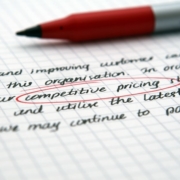The Perfect Sales Letter (Part 2) – 12 Key Components
Occasionally, I’m asked the question, “How long should a sales letter be?”
My answer every time is…”as long as it needs to be to make the sale.” That means, you’ll require ample space to build a relationship…make bold claims…prove those claims…introduce your product as the best solution…and make your prospect an offer, among others.
As you can see, this task could easily generate 10-20 pages of copy before you’re through.
In fact, in every case study I’ve seen to-date—including this one—pitting long copy against short copy, longer sales letters always convert better than shorter ones.
So, just like getting to know a new girlfriend…in-law…friend…appliance or home improvement store salesman…or neighborhood grocer, your reader needs to spend ample time getting to know you in your sales letter. To get his questions answered to his satisfaction before trusting you enough to make a purchase.
The longer the sales copy, the greater the opportunity to make your case to him.
However, you shouldn’t write long just for the sake of being long. Do it to provide your reader with as much information as needed to motivate them to buy.
In other words, some products offered to certain prospects may only take three pages to build your case sufficiently…and create higher conversions. Others may require 20+ pages to do the job well.
Yet, have you ever wondered what exactly should go into a sales letter? Last time, I showed you the specific steps for writing an effective sales letter.
Now, I’ll outline for you…
Table of Contents
12 key components of the perfect sales letter template
Use it as a sort of sales letter template to design your next promotion. And frankly, you can tweak this template for just about any type of direct response copy or promotion, including email, website home page, advertorial, small display ad, and more. Include or omit as you see fit.
With that, here are 12 key ingredients—or sections—you should include in any sales letter to make it a winner every time.
THE HEADLINE
Eyebrow Copy. This short piece of copy is the first part of your headline. And, is found at the top of your sales letter preceding the main headline. It’s known by other names too…superscript, mini-headline, pre-head…to name a few. Its job is basically to “qualify” your ideal prospect by arousing their curiosity or affirming a problem they face. You’re essentially saying, “If you belong to this group, this message is for you…so pay attention.
 How about some examples…
How about some examples…
“If you’re a man over 40, a hormonal shift could be sabotaging your manhood. But today, we reveal how to…”
In this eyebrow copy, men who are over 40 and suffering from any male-related physical, mental, or sexual issues will identify with this promotion and want to continue reading on to the main headline.
Or,
“Urgent message for parents raising a child with autism!”
This is a great example of eyebrow copy. See how clearly and quickly a reader can determine whether this message is worth reading?
However, not all successful promotions use eyebrow copy.
If you choose to use eyebrow copy, make the text slightly larger than your standard body font and bold-faced, so it stands out a bit more. You could even color it—like dark red or dark blue—for effect.
Main Headline. The main headline of your promotion is your first opportunity to really grab your reader’s attention. And, you’ve got about three seconds to do just that.
So, be sure to spend ample time writing any headline—even back-up headlines. Plus, you might want to split-test them to maximize conversions.
Typically, the best way to create an effective headline is to:
- Make a big, bold promise (Drop 45 Pounds in Just 21 Days!)
- State a fact. (Why Most Health Foods are a Waste of Money)
- Paint a picture in their mind. (Look and Feel Decades Younger by Eating Out of…the Trash?)
- Ask a question. (Are These Three Chemicals Causing Your Fatigue?)
However, whatever method you employ, just make sure it targets that one core emotion—like vanity, fear, anger, embarrassment, or other—you are trying to stir in your reader. It’s what motivates him to continue reading.
Also, make sure your main headline stands out from the rest of the copy with much larger font size and bold-faced. Coloring it can also make it more effective at grabbing attention.
Deck Copy. This copy typically follows the main headline. Some folks might refer to it as the main subhead. Its purpose is to expand on the main headline, and is often comprised of bulleted items that amplify the main headline. And yes…it is considered part of the headline because of its direct tie to your letter’s overall big idea or theme.
Another older version of deck copy is called a Johnson Box. Same purpose—to list or outline the benefits suggested in the main headline. Plus, it often teases about what’s to follow. Why “box”? Simple. Because graphically you would draw a line around it making the text look “boxed in”.
Similar to eyebrow copy, you have some leeway with deck copy. You may choose to skip deck copy altogether. If you do write deck copy, you should make the font slightly larger than the standard body font and bold-faced.
THE BODY
The Lead. This section usually follows right after the headline. Typically, it starts with, “Dear Reader,” “Dear Health Enthusiast,” “Dear Greg,”…you get the point.
Check out step 6 of part one on how to write the perfect sales letter above. There, I talk a bit about the goal of your lead and how to develop it. Plus, I introduce the types of leads as they relate to your audience…what the goal of your lead is…and one critical technique to help capture your reader’s attention so they “care” enough to read further.
The lead is basically the beginning of the body of your sales letter template. How long should it be? A good rule of thumb is to make your lead about 20% of your body copy. However, you should spend a good third of your entire research and writing time on developing your lead. Because this is your chance to really connect with your ideal prospect…and motivate them to read further into your promotion.
The Sales Argument. This component of the sales letter is where you should re-state the reader’s problem, and indicate that you have the solution. Then, spend whatever amount of time is necessary to sufficiently prove to your reader that what you say is true.
So first, restate your big promise or re-make a claim. Then, introduce the solution and prove it does what you say. Back it up with studies, customer testimonials, author/formulator credentials, or other social proof.
Sometimes, you may choose to present several solutions. For example, if you are selling a nutritional supplement, you might want to introduce two, three, four, or more ingredients from the list as solutions, talk about their benefits, and list scientific proof to back it up.
Then, list other arguments for your solutions, or against trying other solutions. For example, in the wellness industry, it’s often beneficial to make claims against trying conventional therapies like drugs and surgery. Plus, it’s easy to uncover the science that proves this.
But remember, no gimmicks! Just prove claims, promises, and benefits with sound science or anecdotal evidence.
Product (or Service) Introduction. This is where you finally introduce your product or service to your reader. And, continue your argument as to why it’s the best choice for solving his problem.
 So, talk about your product’s biggest benefits—and what he’ll get from them. You can list its features—like the sections of an eBook—but be sure to include many benefits with each feature.
So, talk about your product’s biggest benefits—and what he’ll get from them. You can list its features—like the sections of an eBook—but be sure to include many benefits with each feature.
State and explain your product’s unique selling proposition (USP). What makes it stand out from others on the market. While you should repeatedly talk about the benefits of trying your solution, try to be as specific as possible to gain a deeper emotional connection with your reader.
Plus, you want your reader to always feel like he was sitting face-to-face—in a real conversation—talking with a friend. It makes you more believable. Now may be a good time to revisit my previous post on writing in a more conversational tone.
Lastly—to make your body copy easier to read—break it up by strategically locating plenty of side bars with graphics and text on either side of your page…using bulleted lists…writing long and short sentences (but mostly short) in alternating long and short paragraphs…and placing subheads at the beginning of each section covering a distinct topic.
THE CLOSE
The Offer. This part of your letter is where you cement the buying decision in your reader’s mind. How?
By repeating your big promise and the many benefits your reader will get if only he tries your solution. This would be a good time to reveal an “extra” benefit he hasn’t heard about yet. Remember…it is essential to do all this right before telling him what it’ll cost.
Then, reveal the price he’ll pay, and what he’ll get for saying yes. Just make sure your offer is to the point, crystal clear—but never clever!
The Premium. This is a bonus gift or two you offer to further entice your reader to take you up on your offer. Here are a couple things to remember:
- Special reports, case studies, and eBooks make great bonuses…across all industries and niches. You can even create these in advance so they’re ready when you need them.
- It should relate to the item you’re selling. So, if you’re selling an anti-aging supplement, offer a special report on anti-aging secrets.
- Create a sense of urgency. So, if they sign up on your exclusive auto-ship program, they get free shipping for life.
- These “freebies” must be seen as valuable. In other words, if it appears you just whipped something together or the actual information is something they’ve seen before, they’ll see you as a cheapskate…and bolt.
But give something perceived as extremely valuable and you’ll make a quick sale. (Hint: a great place to put a CTA button is right after introducing a bonus gift…see the Call-to-Action below). In fact, there have been instances where people said they purchased a product just to get the bonuses!
The Guarantee. Tell your prospect he’s got nothing to lose by trying your solution. And give him your best possible money-back guarantee. The response you want to get from your reader is this…”Awesome, if I don’t like the product, I can always get my money back.”
Couple rules of thumb:
- State the actual terms. In other words, don’t make a fleeting mention that you offer a guarantee. Your reader wants to know in clear terms what he’ll need to do to get his money back. And, this reassurance is his “tipping point” for buying.
- Stronger is better. For example, 90 days is better than a 60 days…1 year is better than 6 months. And, don’t stop at “100% Money-Back Guarantee.” Instead, say “Exclusive 100% Satisfaction, No Questions Asked, Money-Back Guarantee…for a Full 90 Days!”
- Adequately “sell” it. So, don’t just write a single line about your Guarantee and be done with it. Brag it up a bit so your reader “gets” that it’s credible. Writing 2-3 paragraphs or 6-10 sentences is about right.
- Be sure to mention they can keep their bonus gift—even if they return the product and get their money back!
Because guarantees are so important to the success of your sales letter, in the future, I’ll dedicate an entire post on writing guarantees. Be sure to come back and check it out.
The Call-to-Action. Called a CTA, here’s where you ask for the sale. Restate the offer and tell your reader exactly what you want them to do.
Besides, if you’ve stated your sales argument well enough…made a clear, compelling offer…and backed it up with a powerful bonus gift and guarantee, the reader will be ready to do what you tell him. So…tell him!
But remember, CTA’s must:
- Be easy to spot, and strategically located throughout your promotion. Three or four is a good number to shoot for.
- Provide a high-converting “button” with persuasive, action-oriented copy. Consider split-testing for button copy, location, color, or shape to increase conversions.
- Inform the reader exactly what will happen when they “click” the button. Include product quantity, cost, premiums, S&H terms, and savings.
The Sign-Off. Here, be brief. Usually, write a few parting words that seem friendly and genuine, like “To healthy aging,”. Then, the printed name and title of the letter’s “author”, as well as their signature.
The P.S. The postscript comes right after the sign-off. For readers still sitting on the fence, it’s a last-ditch effort to help them cross over from “prospect” to “customer”.
So, use it to remind the reader of your irresistible offer…indicate scarcity with a limited time or quantity offer…reiterate the most compelling benefits or introduce a powerful new benefit…restate your money-back guarantee…and more.
Yet, believe it or not, the P.S. is often one of the first parts of the sales letter that gets read. Increasingly, prospects in a hurry go right to it to get a quick highlight of your letter. So, it’s critical you spend ample time on it. Including making sure it mentions a deeper emotional benefit or bonus gift.
And, go ahead and use a P.P.S, or even a P.P.P.S if you feel they’ll take your reader over the “tipping point.”
Want your next sales letter to feel easier? Try applying these same key components used by all professional copywriters to your next promotion. Using this sales letter template, you’ll soon be writing the perfect sales letter…quicker and easier than you ever thought possible! Alternatively, hire a freelance sales copywriter to write the letters for you.
Think I missed a key ingredient? Why not share it with our readers in the comment section below.
About the Author

Jerry Bures is a direct-response web copywriter and marketing consultant. Since 2010, he has helped natural health, self-help and business opportunity clients—as well as local small businesses—become more visible, credible and profitable online.



